A Study on the Mechanical Properties of Glass-Fiber-Reinforced Defective Gypsum Boards
Abstract
:1. Introduction
2. Materials and Methods
2.1. Specimen Preparation
2.2. Cyclic Loading and Unloading Test Program
3. Results and Discussion
3.1. Uniaxial Compression Experiments
3.2. Repeat Loading Experiments
3.3. Energy Evolution
3.4. Residual Strain
3.5. Damage Factor
3.6. Destruction Characteristics
3.7. Microscopic Electron Microscope Analysis
4. Conclusions
5. Research Shortcomings and Future Work
Author Contributions
Funding
Institutional Review Board Statement
Informed Consent Statement
Data Availability Statement
Conflicts of Interest
References
- Li, Q.; Zhao, G.F.; Lian, J. Further Development of the Distinct Lattice Spring Model for Quasi-Brittle Crack Propagation in Concrete and Its Application in Underground Engineering. Tunn. Undergr. Space Technol. 2019, 92, 103061. [Google Scholar] [CrossRef]
- Yu, Z.; Shan, Z.; Mao, J. Fatigue Deterioration of Quasi-Brittle Materials. Int. J. Fatigue 2019, 118, 185–191. [Google Scholar] [CrossRef]
- Nguyen, H.Q.; Han, T.H.; Park, J.K.; Kim, J.J. A Design Process for Preventing Brittle Failure in Strengthening RC Slabs with Hybrid FRP-HPC Retrofit Systems. Materials 2023, 16, 755. [Google Scholar] [CrossRef] [PubMed]
- Tan, L.; Yang, J.; Li, C.; Zhang, G.; Ding, Q.; Sun, D. Effect of Polyoxymethylene Fiber on the Mechanical Properties and Abrasion Resistance of Ultra-High-Performance Concrete. Materials 2023, 16, 7014. [Google Scholar] [CrossRef] [PubMed]
- Bars, G.F.P. Numerical Analysis of Concrete Deep Beams Reinforced with Glass Fiber-Reinforced Polymer Bars. Buildings 2023, 13, 2767. [Google Scholar]
- Xu, D.; He, S.; Leng, W.; Chen, Y.; Wu, Z. Replacing Plastic with Bamboo: A Review of the Properties and Green Applications of Bamboo-Fiber-Reinforced Polymer Composites. Polymers 2023, 15, 4276. [Google Scholar] [CrossRef] [PubMed]
- Song, K.; Yu, Y.; Liu, Y.; Zhao, J. Flexural Performance Study of Basalt-Fiber-Reinforced Polymer Bar Basalt-Fiber-Reinforced Concrete Beams. Buildings 2023, 13, 2583. [Google Scholar] [CrossRef]
- Bieler, S.; Haller, S.; Brandt, R. Experimental Investigation of Unidirectional Glass-Fiber-Reinforced Plastics under High Strain Rates. Appl. Mech. 2023, 4, 1127–1139. [Google Scholar] [CrossRef]
- Lira-martinez, M.A.; Gaona-tiburcio, C.; Almeraya-calderon, F.; Jaquez-muñoz, J.M.; Zalapa-garibay, M.A. Experimental Study of the Influence of Stitched Nylon Threads in Glass-Fiber-Reinforced Polymer Two-Dimensional Multilayer Composite on Tensile Strength. Appl. Sci. 2023, 13, 11679. [Google Scholar] [CrossRef]
- Polymer, G.F.; Tube, P. Experimental Investigation and Prediction for Bending Creep of Glass Fiber-Reinforced Polymer Pultruded Tube. Buildings 2023, 13, 2714. [Google Scholar]
- Polypropylene, F.; Mohammadkarimi, S.; Neitzel, B.; Lang, M. Investigation of the Fiber Length and the Mechanical Properties of Waste Recycled from Continuous Glass. Recycling 2023, 8, 82. [Google Scholar]
- Chandramouli, K.; Rao, P.S.R.; Narayanan, P.; Sekhar tirumala, S.; Sravana, P. Strength Properties of Glass Fiber Concrete. ARPN J. Eng. Appl. Sci. 2010, 5, 1–6. [Google Scholar]
- Morampudi, P.; Namala, K.K.; Gajjela, Y.K.; Barath, M.; Prudhvi, G. Review on Glass Fiber Reinforced Polymer Composites. Mater. Today Proc. 2020, 43, 314–319. [Google Scholar] [CrossRef]
- Aliha, M.R.M.; Karimi, H.R.; Abedi, M. The Role of Mix Design and Short Glass Fiber Content on Mode-I Cracking Characteristics of Polymer Concrete. Constr. Build. Mater. 2022, 317, 126139. [Google Scholar] [CrossRef]
- Tassew, S.T.; Lubell, A.S. Mechanical Properties of Glass Fiber Reinforced Ceramic Concrete. Constr. Build. Mater. 2014, 51, 215–224. [Google Scholar] [CrossRef]
- Zhang, C.; Zhu, Z.; Wang, S.; Zhang, J. Macro-Micro Mechanical Properties and Reinforcement Mechanism of Alkali-Resistant Glass Fiber-Reinforced Concrete under Alkaline Environments. Constr. Build. Mater. 2023, 368, 130365. [Google Scholar] [CrossRef]
- Wei, J.; Mao, X.; Xu, W.; Xi, C.; Yan, S.; Sun, T.; Hu, X.; Wang, Y.; Chi, F. Experimental Research on the Effect of Fiberglass on the Performance of Epoxy Asphalt Concrete. Sustainability 2022, 14, 4724. [Google Scholar] [CrossRef]
- Zhao, T.; Lv, Y.; Chen, J.; Song, P.; Sun, M.; Zhang, X.; Huang, L. Effect of Glass Fiber-Reinforced Plastic Waste on the Mechanical Properties of Concrete and Evaluation of Its Feasibility for Reuse in Concrete Applications. Materials 2023, 16, 6772. [Google Scholar] [CrossRef] [PubMed]
- Arunachalam, K.P.; Avudaiappan, S.; Flores, E.I.S.; Parra, P.F. Experimental Study on the Mechanical Properties and Microstructures of Cenosphere Concrete. Materials 2023, 16, 3518. [Google Scholar] [CrossRef]
- Zhou, P.; Li, C.; Bai, Y.; Dong, S.; Xian, G.; Vedernikov, A.; Akhatov, I.; Safonov, A.; Yue, Q. Durability Study on the Interlaminar Shear Behavior of Glass-Fibre Reinforced Polypropylene (GFRPP) Bars for Marine Applications. Constr. Build. Mater. 2022, 349, 128694. [Google Scholar] [CrossRef]
- Zuaiter, M.; El-Hassan, H.; El-Ariss, B.; El-Maaddawy, T. Early-Age Properties of Slag-Fly Ash Blended Geopolymer Concrete Reinforced with Glass Fibers–A Preliminary Study. In Proceedings of the 7 th World Congress on Civil, Structural, and Environmental Engineering (CSEE’22), Virtual, 10–12 April 2022. [Google Scholar] [CrossRef]
- Sikder, A.; Mishra, J.; Krishna, R.S.; Ighalo, J.O. Evaluation of the Mechanical and Durability Properties of Geopolymer Concrete Prepared with C-Glass Fibers. Arab. J. Sci. Eng. 2022, 48, 12759–12774. [Google Scholar] [CrossRef]
- Liu, Y.; Zhang, H.T.; Tafsirojjaman, T.; Ur Rahman Dogar, A.; AlAjarmeh, O.; Yue, Q.R.; Manalo, A. A Novel Technique to Improve the Compressive Strength and Ductility of Glass Fiber Reinforced Polymer (GFRP) Composite Bars. Constr. Build. Mater. 2022, 326, 126782. [Google Scholar] [CrossRef]
- Li, Y.F.; Hsu, Y.W.; Syu, J.Y.; Chen, B.Y.; Song, B. Study on the Utilization of Waste Thermoset Glass Fiber-Reinforced Polymer in Normal Strength Concrete and Controlled Low Strength Material. Materials 2023, 16, 3552. [Google Scholar] [CrossRef] [PubMed]
- Kumar, Y.N.; Dean Kumar, B.; Swami, B.L.P. Mechanical Properties of Geopolymer Concrete Reinforced with Steel and Glass Fibers with Various Mineral Admixtures. Mater. Today Proc. 2022, 52, 632–641. [Google Scholar] [CrossRef]
- Ma, S.; Hou, D.; Bao, P.; Wang, D. Influence of Alkali-Resistant Glass Fiber on Seismic Performance of Precast Ceramsite Concrete Sandwich Wall Panels. Structures 2022, 38, 94–107. [Google Scholar] [CrossRef]
- Lim, C.S.; Jang, D.S.; Kim, J.C.; Kim, H.S.; Lee, J.J. A Study on the Applicability of Waste Glass Wool and Waste Mineral Wool as Fiber Reinforcement. Appl. Sci. 2023, 13, 10738. [Google Scholar] [CrossRef]
- Mohsen, A.; Kohail, M.; Abadel, A.A.; Alharbi, Y.R.; Nehdi, M.L.; Ramadan, M. Case Studies in Construction Materials Correlation between Porous Structure Analysis, Mechanical Efficiency and Gamma-Ray Attenuation Power for Hydrothermally Treated Slag-Glass Waste-Based Geopolymer. Case Stud. Constr. Mater. 2022, 17, e01505. [Google Scholar] [CrossRef]
- Ramadan, M.; Amin, M.S.; Waly, S.A.; Mohsen, A. Effect of High Gamma Radiation Dosage and Elevated Temperature on the Mechanical Performance of Sustainable Alkali-Activated Composite as a Cleaner Product. Cem. Concr. Compos. 2021, 121, 104087. [Google Scholar] [CrossRef]
- Ramadan, M.; Habib, A.O.; Kohail, M.; Mohsen, A. Enhancement of Fresh and Hardened Properties of Geopolymeric Composite Containing Toxic Lead Sludge: A Comparative Study between the Effect of Superplasticizer and Thermal Treatment of Sludge. J. Build. Eng. 2023, 71, 106482. [Google Scholar] [CrossRef]
- Essam, Y.; El-faramawy, N.; Ramadan, W.; Ramadan, M. From Dangerous Wastes to Green Construction Materials, as Thermally Stable-Radiation Blocker, in Presence of Meso-Porous Magnesia and Alumina. J. Build. Eng. 2023, 66, 105896. [Google Scholar] [CrossRef]
- Mohamed, O.A.; Hazem, M.M.; Mohsen, A.; Ramadan, M. Impact of Microporous γ-Al2O3 on the Thermal Stability of Pre-Cast Cementitious Composite Containing Glass Waste. Constr. Build. Mater. 2023, 378, 131186. [Google Scholar] [CrossRef]
- Ramadan, M.; Kohail, M.; Alharbi, Y.R.; Abadel, A.A.; Binyahya, A.S.; Mohsen, A. Investigation of Autoclave Curing Impact on the Mechanical Properties, Heavy Metal Stabilization and Anti-Microbial Activity of the Green Geopolymeric Composite Based on Received/Thermally-Treated Glass Polishing Sludge. J. Mater. Res. Technol. 2022, 23, 2672–2689. [Google Scholar] [CrossRef]
- Shwita, F.; El-faramawy, N.; Ramadan, W.; Ramadan, M. Investigation of the Mechanical Properties, Morphology and the Attenuation Behavior of Gamma Rays for OPC Pastes Mingled with Two Different Glass Wastes. Constr. Build. Mater. 2021, 313, 125475. [Google Scholar] [CrossRef]
- Ramadan, M.; Selim, F.A. Mechanical Properties, Radiation Mitigation and Fire Resistance of OPC-Recycled Glass Powder Composites Containing Nanoparticles. Constr. Build. Mater. 2020, 251, 118703. [Google Scholar] [CrossRef]
- Ramadan, M.; Habib, A.O.; Hazem, M.M.; Amin, M.S.; Mohsen, A. Synergetic Effects of Hydrothermal Treatment on the Behavior of Toxic Sludge-Modified Geopolymer: Immobilization of Cerium and Lead, Textural Characteristics, and Mechanical Efficiency. Constr. Build. Mater. 2023, 367, 130249. [Google Scholar] [CrossRef]
- Ramadan, M.; Ramadan, W.; Shwita, F.; El-faramawy, N. Valorization of Hazardous Glass Wastes via Geopolymer Production Utilized in Gamma Ray Shielding Applications: A Comparative Study with Portland Cement. Radiat. Phys. Chem. 2022, 197, 110174. [Google Scholar] [CrossRef]
- Mastali, M.; Dalvand, A.; Sattarifard, A.R. The Impact Resistance and Mechanical Properties of Reinforced Self-Compacting Concrete with Recycled Glass Fibre Reinforced Polymers. J. Clean. Prod. 2016, 124, 312–324. [Google Scholar] [CrossRef]
- Katabira, K.; Miyashita, T.; Narita, F. Stress Monitoring Capability of Magnetostrictive Fe–Co Fiber/Glass Fiber Reinforced Polymer Composites under Four-Point Bending. Sci. Rep. 2022, 12, 1–12. [Google Scholar] [CrossRef]
- Phani, K.V.S.; Nanda, B.K.; Mishra, S.B.; Nayak, S.K. Structural Analysis of Experimentally Fabricated Glass Fiber Reinforced (GFRP) Composites. Mater. Today Proc. 2023, 74, 889–894. [Google Scholar] [CrossRef]
- Mirza, F.A.; Soroushian, P. Effects of Alkali-Resistant Glass Fiber Reinforcement on Crack and Temperature Resistance of Lightweight Concrete. Cem. Concr. Compos. 2002, 24, 223–227. [Google Scholar] [CrossRef]
- Blazy, J.; Blazy, R.; Drobiec, Ł. Glass Fiber Reinforced Concrete as a Durable and Enhanced Material for Structural and Architectural Elements in Smart City—A Review. Materials 2022, 15, 2754. [Google Scholar] [CrossRef] [PubMed]
- Dehghan, A.; Peterson, K.; Shvarzman, A. Recycled Glass Fiber Reinforced Polymer Additions to Portland Cement Concrete. Constr. Build. Mater. 2017, 146, 238–250. [Google Scholar] [CrossRef]
- Tibebu, A.; Mekonnen, E.; Kumar, L.; Chimdi, J.; Hailu, H.; Fikadu, N. Compression and Workability Behavior of Chopped Glass Fiber Reinforced Concrete. Mater. Today Proc. 2022, 62, 5087–5094. [Google Scholar] [CrossRef]
- Kumar Sharma, S.; Mehta, S. Experimental Study on Effect of Glass Fibre on Concrete Using Recycled Aggregate. Mater. Today Proc. 2023, in press. [CrossRef]
- JCT 2038-2010; Standard for α-High Strength Gypsum Plaster. Available online: https://max.book118.com/html/2019/0115/6002124241002001.shtm (accessed on 9 January 2024).




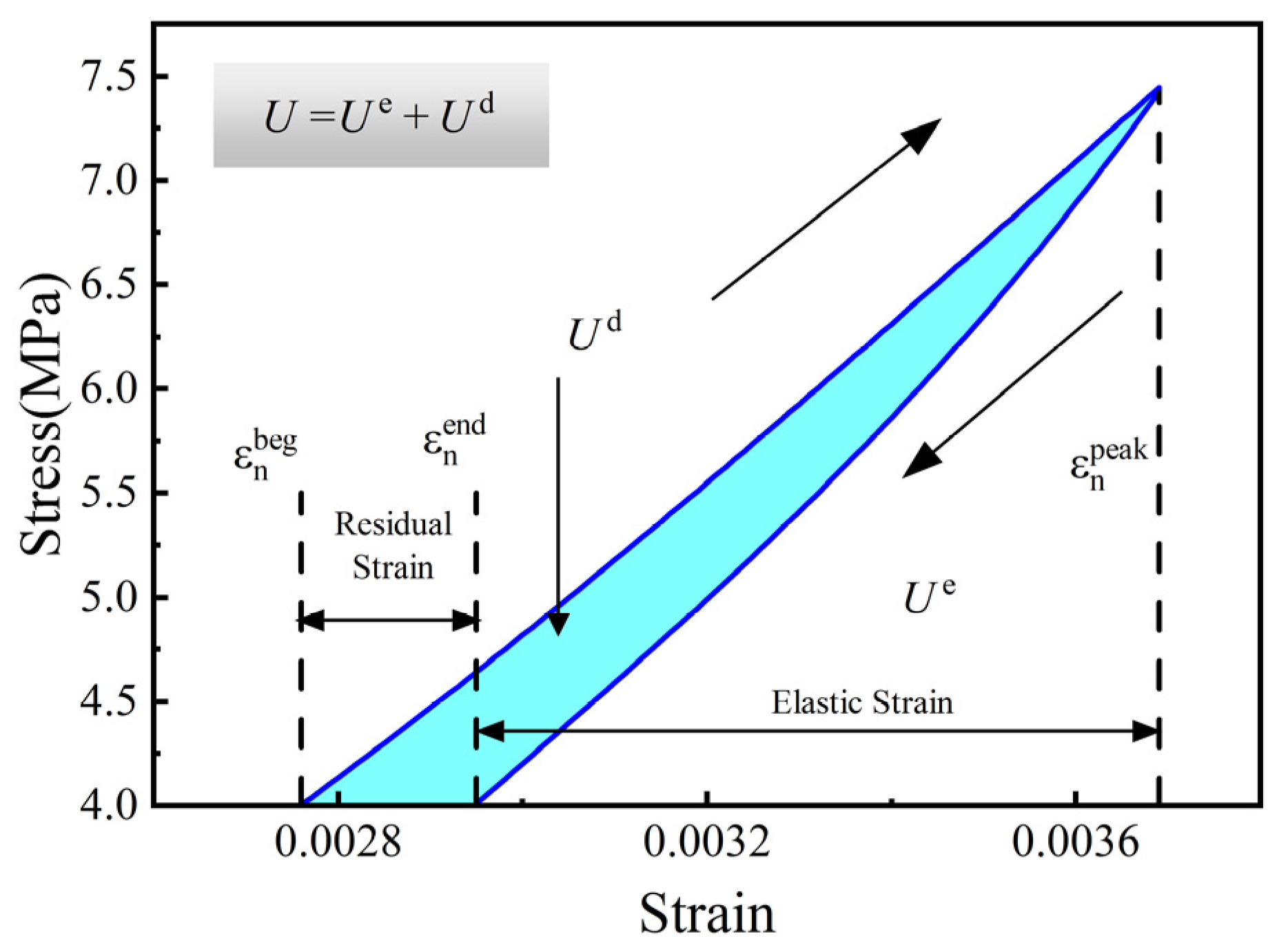
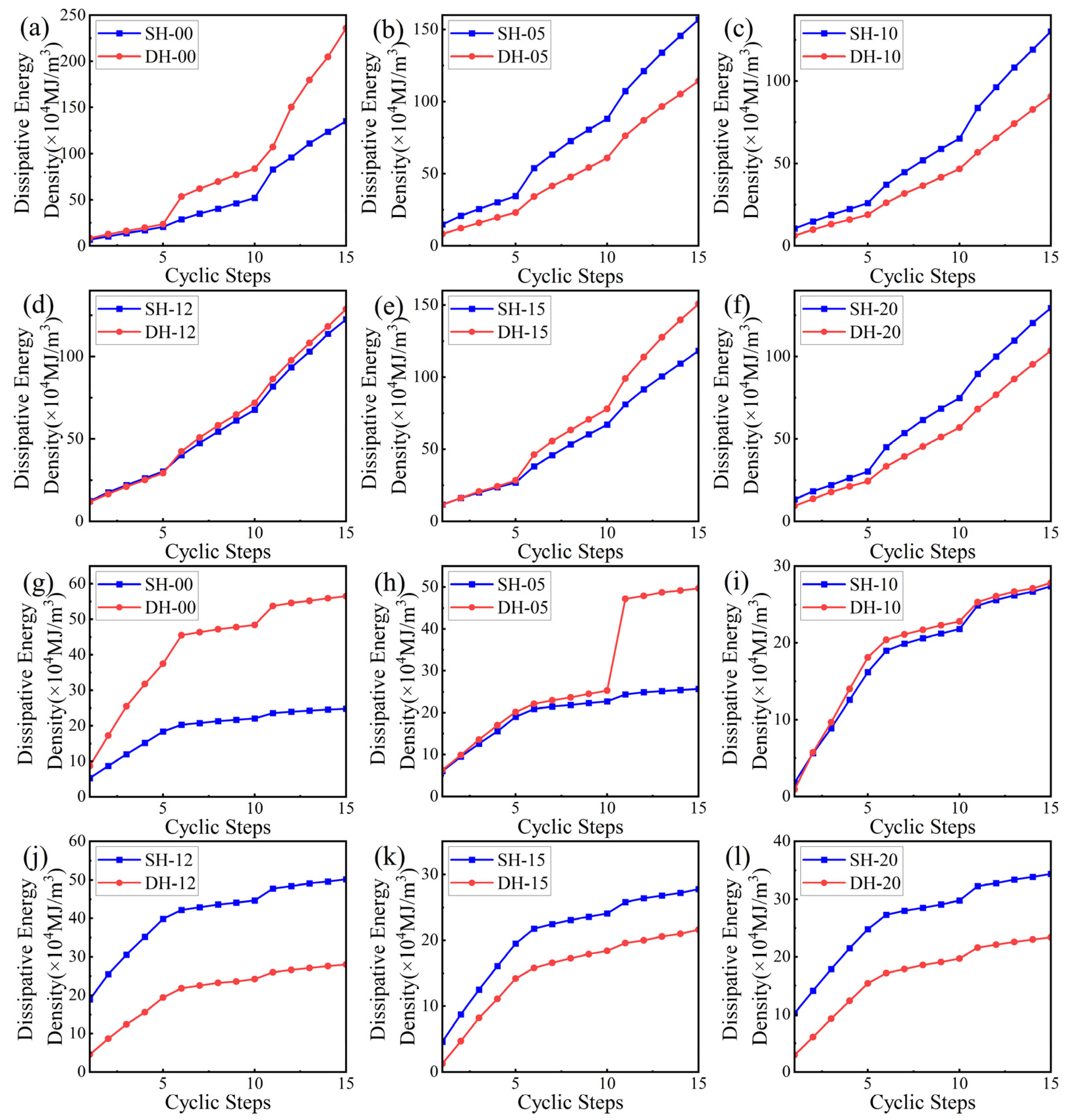

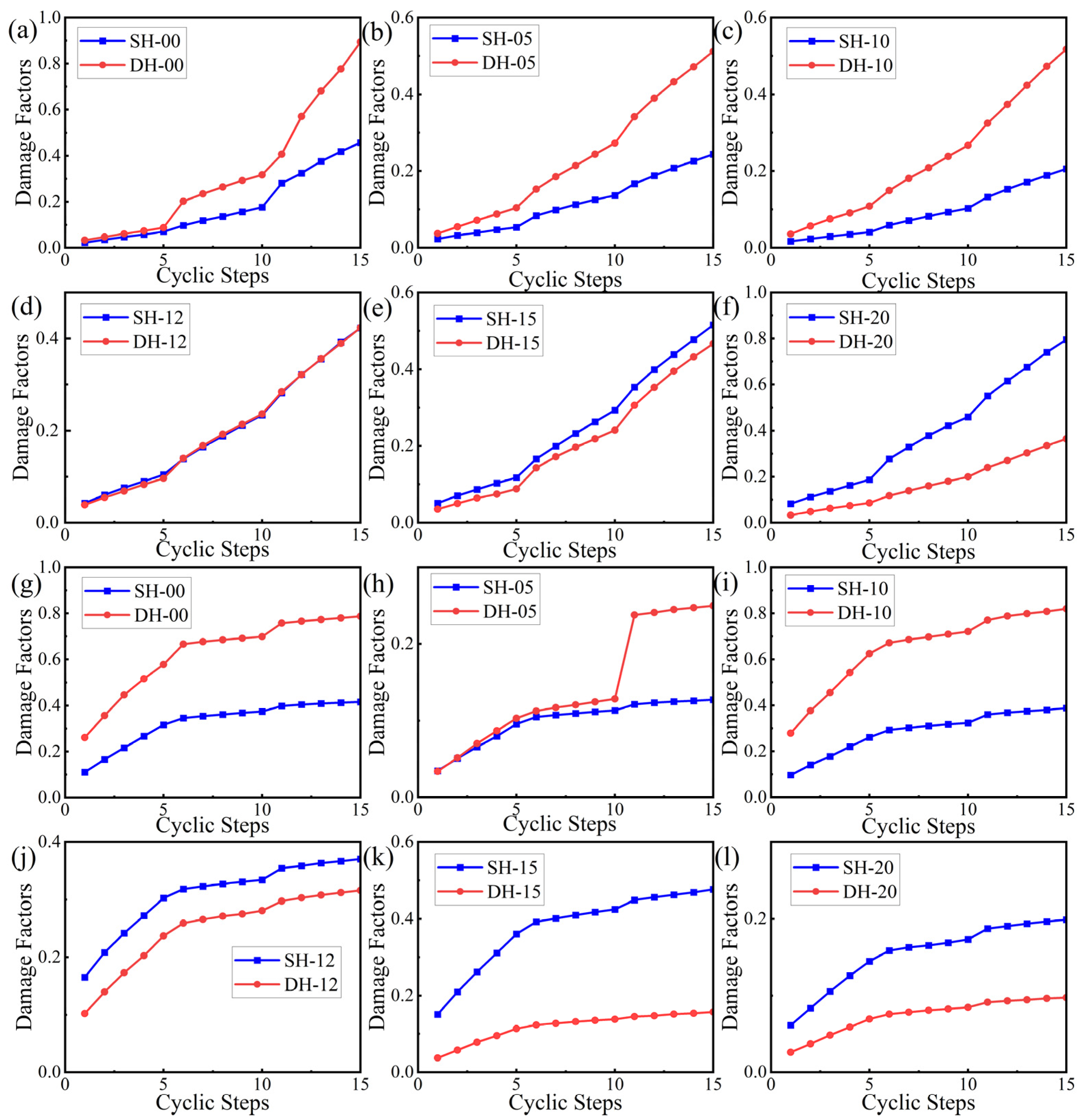
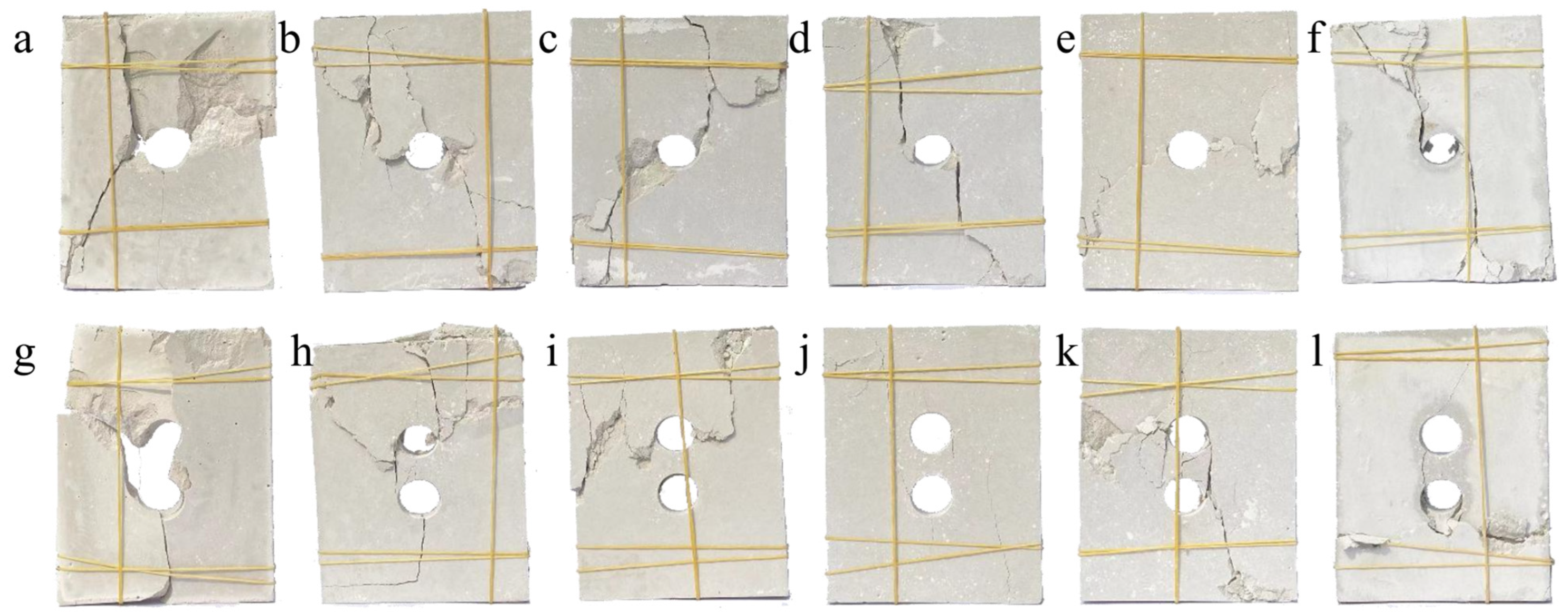
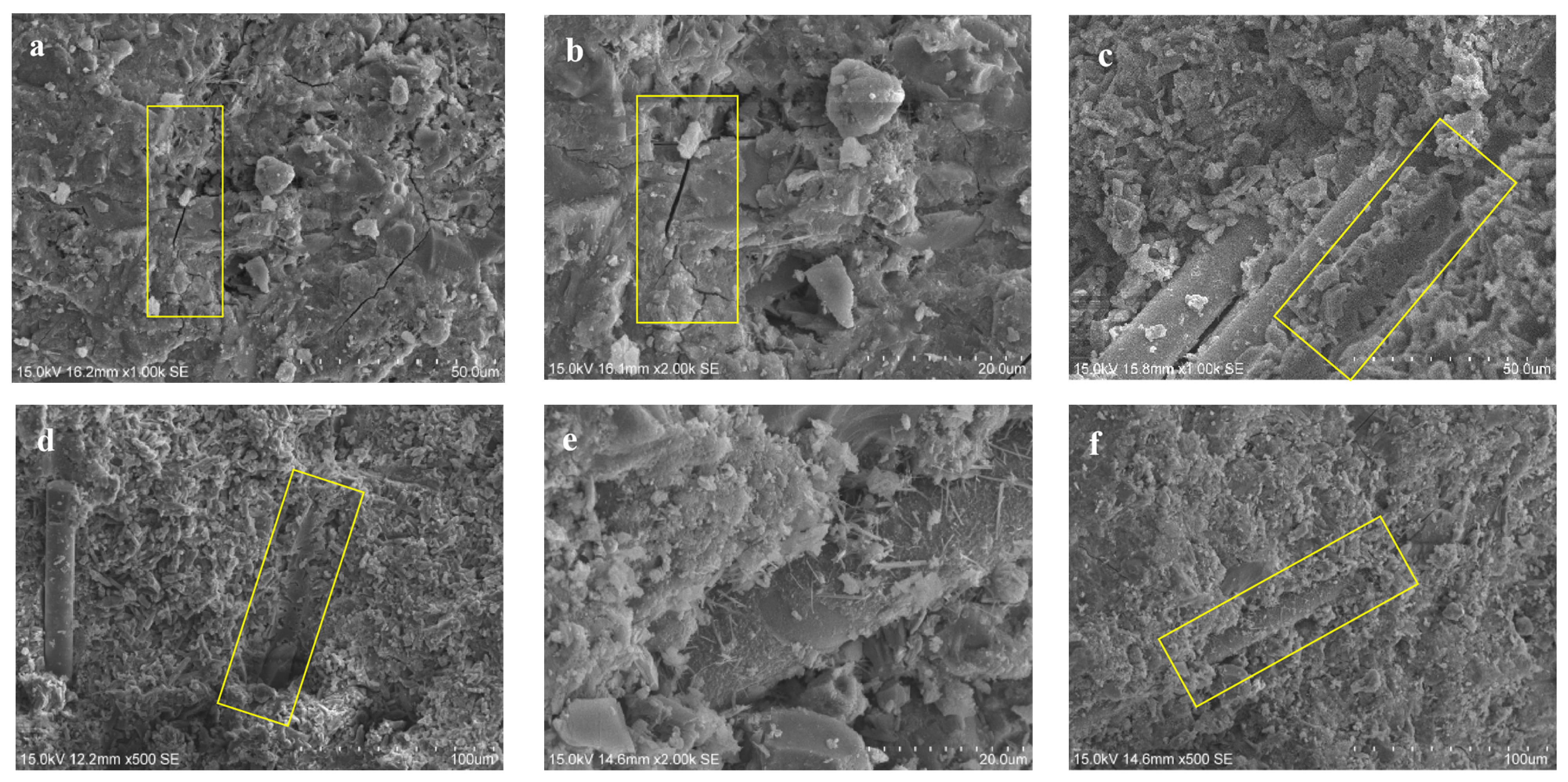
| Gypsum Properties | Gypsum |
|---|---|
| Compressive strength (MPa) | 6.18–12.75 |
| Flexural strength (MPa) | 4.67–9.25 |
| Loss on ignition | 13–15% |
| Fiber Properties | Glass Fiber |
|---|---|
| Specific gravity (g/cm3) | 3.63 |
| Tensile strength (MPa) | 4000 |
| Diameter (μm) | 10 |
| Length(cm) | 3 |
| Modulus of elasticity (GPa) | 105 |
| Composition | Percentage (%) |
|---|---|
| Gypsum | 77.8 |
| Water | 19.46 |
| Water-reducing agent | 1.95 |
| Defoaming agent | 0.79 |
| Specimens | SH-00 | SH-05 | SH-10 | SH-12 | SH-15 | SH-20 |
|---|---|---|---|---|---|---|
| Uniaxial compression/(MPa) | 12.99 | 19.19 | 17.92 | 22.42 | 23.01 | 23.06 |
| Specimens | DH-00 | DH-05 | DH-10 | DH-12 | DH-15 | DH-20 |
| Uniaxial compression/(MPa) | 11.38 | 18.31 | 15.66 | 18.67 | 20.43 | 21.30 |
| Specimens | SH-00 | SH-05 | SH-10 | SH-12 | SH-15 | SH-20 |
|---|---|---|---|---|---|---|
| CSRLE/(MPa) | 14.79 | 21.45 | 18.04 | 18.84 | 22.03 | 19.91 |
| VSRLE/(MPa) | 13.25 | 20.18 | 14.65 | 17.80 | 23.21 | 20.57 |
| Specimens | DH-00 | DH-05 | DH-10 | DH-12 | DH-15 | DH-20 |
| CSRLE/(MPa) | 9.55 | 18.61 | 17.44 | 22.31 | 22.62 | 22.51 |
| VSRLE/(MPa) | 7.23 | 16.21 | 14.84 | 22.58 | 23.07 | 22.38 |
Disclaimer/Publisher’s Note: The statements, opinions and data contained in all publications are solely those of the individual author(s) and contributor(s) and not of MDPI and/or the editor(s). MDPI and/or the editor(s) disclaim responsibility for any injury to people or property resulting from any ideas, methods, instructions or products referred to in the content. |
© 2024 by the authors. Licensee MDPI, Basel, Switzerland. This article is an open access article distributed under the terms and conditions of the Creative Commons Attribution (CC BY) license (https://creativecommons.org/licenses/by/4.0/).
Share and Cite
Wu, D.; Jing, L.; Peng, S.; Jing, W. A Study on the Mechanical Properties of Glass-Fiber-Reinforced Defective Gypsum Boards. Sustainability 2024, 16, 821. https://doi.org/10.3390/su16020821
Wu D, Jing L, Peng S, Jing W. A Study on the Mechanical Properties of Glass-Fiber-Reinforced Defective Gypsum Boards. Sustainability. 2024; 16(2):821. https://doi.org/10.3390/su16020821
Chicago/Turabian StyleWu, Di, Laiwang Jing, Shaochi Peng, and Wei Jing. 2024. "A Study on the Mechanical Properties of Glass-Fiber-Reinforced Defective Gypsum Boards" Sustainability 16, no. 2: 821. https://doi.org/10.3390/su16020821






